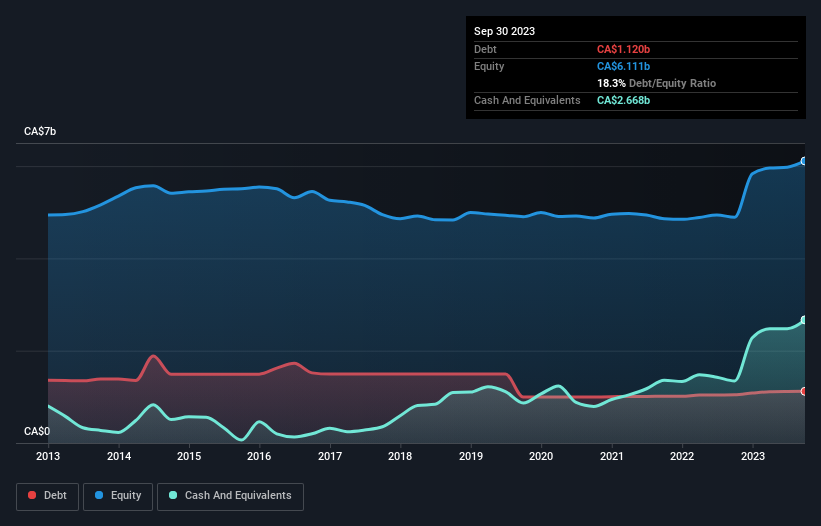The external fund manager backed by Berkshire Hathaway's Charlie Munger, Li Lu, makes no bones about it when he says 'The biggest investment risk is not the volatility of prices, but whether you will suffer a permanent loss of capital.' It's only natural to consider a company's balance sheet when you examine how risky it is, since debt is often involved when a business collapses. As with many other companies Cameco Corporation (TSE:CCO) makes use of debt. But the more important question is: how much risk is that debt creating?
What Risk Does Debt Bring?
Generally speaking, debt only becomes a real problem when a company can't easily pay it off, either by raising capital or with its own cash flow. If things get really bad, the lenders can take control of the business. However, a more frequent (but still costly) occurrence is where a company must issue shares at bargain-basement prices, permanently diluting shareholders, just to shore up its balance sheet. Of course, plenty of companies use debt to fund growth, without any negative consequences. The first thing to do when considering how much debt a business uses is to look at its cash and debt together.
See our latest analysis for Cameco
What Is Cameco's Net Debt?
As you can see below, at the end of September 2023, Cameco had CA$1.12b of debt, up from CA$1.04b a year ago. Click the image for more detail. However, it does have CA$2.67b in cash offsetting this, leading to net cash of CA$1.55b.

How Strong Is Cameco's Balance Sheet?
The latest balance sheet data shows that Cameco had liabilities of CA$956.4m due within a year, and liabilities of CA$1.65b falling due after that. Offsetting these obligations, it had cash of CA$2.67b as well as receivables valued at CA$301.5m due within 12 months. So it can boast CA$359.9m more liquid assets than total liabilities.
Having regard to Cameco's size, it seems that its liquid assets are well balanced with its total liabilities. So while it's hard to imagine that the CA$26.6b company is struggling for cash, we still think it's worth monitoring its balance sheet. Succinctly put, Cameco boasts net cash, so it's fair to say it does not have a heavy debt load!
In addition to that, we're happy to report that Cameco has boosted its EBIT by 52%, thus reducing the spectre of future debt repayments. The balance sheet is clearly the area to focus on when you are analysing debt. But it is future earnings, more than anything, that will determine Cameco's ability to maintain a healthy balance sheet going forward. So if you want to see what the professionals think, you might find this free report on analyst profit forecasts to be interesting.
But our final consideration is also important, because a company cannot pay debt with paper profits; it needs cold hard cash. While Cameco has net cash on its balance sheet, it's still worth taking a look at its ability to convert earnings before interest and tax (EBIT) to free cash flow, to help us understand how quickly it is building (or eroding) that cash balance. Happily for any shareholders, Cameco actually produced more free cash flow than EBIT over the last three years. That sort of strong cash generation warms our hearts like a puppy in a bumblebee suit.
Summing Up
While it is always sensible to investigate a company's debt, in this case Cameco has CA$1.55b in net cash and a decent-looking balance sheet. The cherry on top was that in converted 158% of that EBIT to free cash flow, bringing in CA$420m. So is Cameco's debt a risk? It doesn't seem so to us. When analysing debt levels, the balance sheet is the obvious place to start. However, not all investment risk resides within the balance sheet - far from it. We've identified 2 warning signs with Cameco , and understanding them should be part of your investment process.
If, after all that, you're more interested in a fast growing company with a rock-solid balance sheet, then check out our list of net cash growth stocks without delay.
New: AI Stock Screener & Alerts
Our new AI Stock Screener scans the market every day to uncover opportunities.
• Dividend Powerhouses (3%+ Yield)
• Undervalued Small Caps with Insider Buying
• High growth Tech and AI Companies
Or build your own from over 50 metrics.
Have feedback on this article? Concerned about the content? Get in touch with us directly. Alternatively, email editorial-team (at) simplywallst.com.
This article by Simply Wall St is general in nature. We provide commentary based on historical data and analyst forecasts only using an unbiased methodology and our articles are not intended to be financial advice. It does not constitute a recommendation to buy or sell any stock, and does not take account of your objectives, or your financial situation. We aim to bring you long-term focused analysis driven by fundamental data. Note that our analysis may not factor in the latest price-sensitive company announcements or qualitative material. Simply Wall St has no position in any stocks mentioned.
About TSX:CCO
Solid track record with excellent balance sheet.
Similar Companies
Market Insights
Community Narratives



